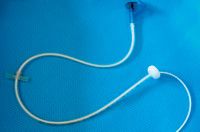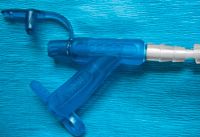Surgery STAT: Gastrojejunostomy tubes improve nutrition
EDITORS NOTE: A new collaborative column with the American College of Veterinary Surgeons (ACVS) and DVM Newsmagazine debuts this month. SurgerySTAT offers DVM readers insightful information for preoperative preparation, a surgical technique or postoperative care.
EDITORS NOTE: A new collaborative column with the American College of Veterinary Surgeons (ACVS) and DVM Newsmagazine debuts this month. SurgerySTAT offers DVM readers insightful information for preoperative preparation, a surgical technique or postoperative care.
"ACVS Diplomates recognize the vital role that general veterinarians and their staffs play in ensuring the best outcome for animals requiring surgical attention," affirms ACVS Executive Director Ann T. Loew. "The goal of the ACVS is to strengthen the partnership between ACVS Diplomates and their professional colleagues. One of the ways the College embraces this concept is by offering educational opportunities for other members of the veterinary profession and the public each year."
"As a magazine, we strive to inform and educate," adds DVM Newsmagazine Editor Daniel R. Verdon. "This unique and exclusive collaboration with ACVS Diplomates will help veterinarians bridge cutting-edge techniques with real-world application. We hope you find this information useful in your pursuit of offering exceptional patient care."
Providing adequate nutrition to dogs and cats in the postoperative patient is vital to ensure healing and rapid recovery. Often, syringe feeding or nasogastric tubes may not provide the full caloric requirements of the critically ill patient. Traditionally, surgically placed feeding tubes have included use of esophagostomy tubes as well as gastrostomy tubes.

Dr. Janet R. Kovak
In animals that require feedings distal to the stomach, such as patients with pancreatitis, gastric-outflow obstruction or gastric atony, jejunostomy tubes have been used. The major concern with placement of jejunostomy tubes in the past has been the potentially high risk for septic peritonitis with tube dislodgement. The use of gastrojejunostomy tubes in dogs and cats has provided an ideal solution. (Photo 1)

Photo 1: Gastrojejunostomy tube
Gastrojejunostomy tubes provide dual access to the stomach as well as the jejunum. A traditional gastrostomy tube (Bard, Ponsky™ Pull PEG) is placed via a left-sided incision through the body of the stomach with a gastropexy to the left body wall. A jejunostomy tube (Bard, Jejunal Feeding/Decompression Tube) is then inserted into the lumen of the gastrostomy tube through the stomach, past the pylorus and duodenum so the tip of the tube ends up in the proximal jejunum. The end of the tube is fitted with a dual lumen port (Photo 2) that allows access to the stomach for gastric decompression as well as access to the jejunum for feedings.

Photo 2: Gastrojejunostomy tube port
General guidelines begin with gradual feeding of a commercially available liquefied diet through the jejunostomy tube approximately 12 to 24 hours following surgery. Removal of the jejunostomy tube is at the discretion of the clinician. Decision-making can be based on patient tolerance of feedings, clinical signs, as well as results of serial blood work and ultrasound evaluations. When the jejunostomy tube is removed, a traditional gastrostomy tube remains.
Risks of tube placement include stoma complications where the tube exits the skin, such as mild erythema or cellulitis. Additionally, mechanical complications may include coiling or orad migration of the jejunostomy tube.
As with any gastrostomy-tube placement, the risk of peritonitis with tube dislodgement exists. In general, these risks are low and the benefits to the patients numerous. Typically these tubes are placed at the time of surgery in cats and dogs with septic peritonitis, pancreatic disease and extrahepatic biliary disease.
Gastrojejunostomy tubes provide post-gastric enteral feedings useful in managing the critically ill patient. They provide the benefits of access to both the stomach and the small intestine, without a jejunostomy. Studies have shown that providing adequate nutrition to the postoperative patient can decrease morbidity and mortality and lead to more rapid recovery.
Dr. Janet R. Kovak is an ACVS board-certified veterinary surgeon. Most recently she served as an instructor of the Minimally Invasive Surgery laboratory at the 2007 ACVS Veterinary Symposium in Chicago. She is a staff surgeon at the Animal Medical Center in New York City.
Newsletter
From exam room tips to practice management insights, get trusted veterinary news delivered straight to your inbox—subscribe to dvm360.